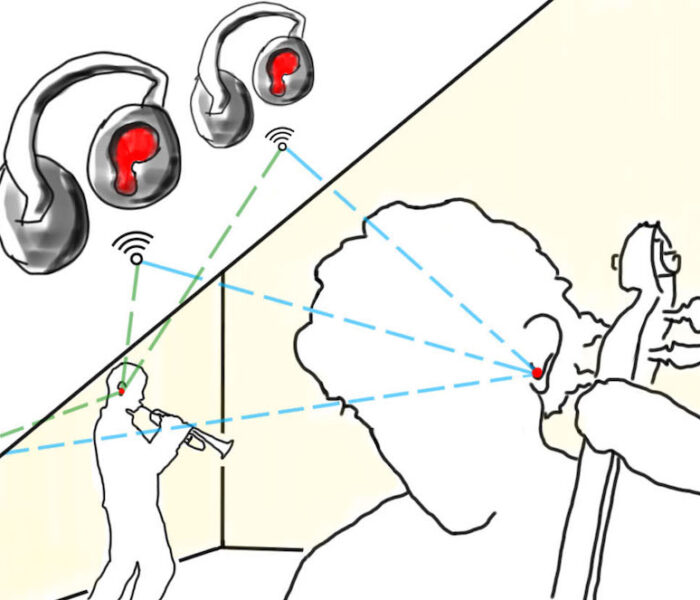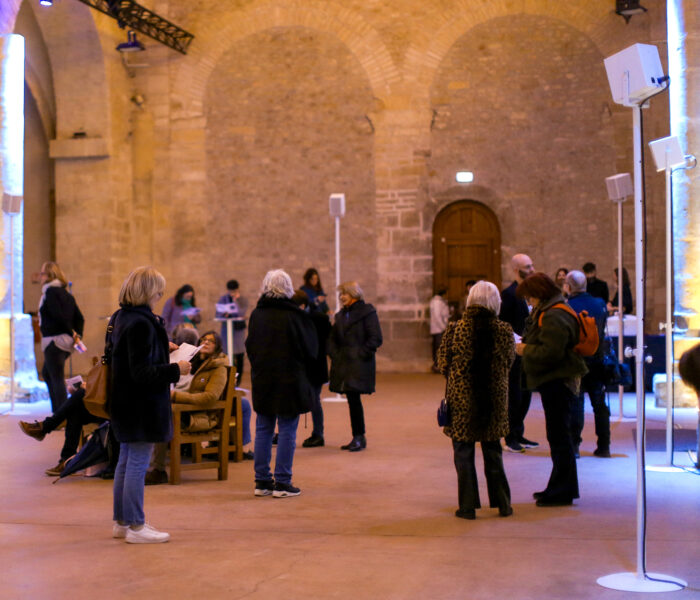At a time when an exhibition is devoted to the work of American composer and musician Pauline Oliveros (1932-2016) at the Bétonsalon Art and Research Center, we would like to return to her practice of listening, and more particularly to the concept of DeepListening, which she conceived, developed and implemented from the late 1950s, notably through her Sonic Meditations, a collection of verbal scores and listening scripts published in 1971.
" I differentiate between 'to hear' and 'to listen'. To hear is the physical means that enables perception. To listen is to give attention to what is perceived both acoustically and psychologically. " This sentence is taken from the preface Pauline Oliveros wrote in June 2003 for the book Deep Listening: A Composer's Sound Practice (Deep Listening Publications, 2005). In it, she seems to reiterate the common distinction between hearing as a perceptual fact and listening as an intentional act. To hear would be to be passively struck, whereas to listen would be to pay attention, to lend an ear - actively and voluntarily - to what strikes us.
However, a little further on, she adds: "Deep coupled with Listening , or Deep Listening,for me is learning to expand the perception of sound to include the whole space/time continuum of sound - encountering the vastness and complexities as much as possible . Simultaneously, one ought to be able to target a sound or sequence of sounds as a focus within the space/time continuum and perceive the detail or trajectory of the sound or sequence of sounds. Such a focus should always return to or be within the whole space/time continuum (context). Such expansion means that one is connected to the whole environment and beyond. "
In a strange reversal, listening as "deep" takes on some of the characteristics of hearing, as if it were a deformed double. Only hearing in the most passive sense of the term, which would then be identified with hearing as a pure and simple auditory organ, would be able to take in the entire sound continuum. And yet it is listening, a paradoxical listening that is both radically unfocused and attentive, open to everything and connected to everything. Deep listening is always an act, but an act that embraces "immensity" without overhanging or reducing it, because it is also capable of lending an ear to its "complexities": of moving into what she would later call the "sonosphere" (1) and connecting with a sound, or sound phenomenon, that deserves attention.
The idea of deep listening is inseparable from two experiences Pauline Oliveros had ten years apart. The first dates back to her adolescence: " When I was sixteen, my accordion teacher taught me to hear combination tones (a resultant sound is the effect of the interaction of two simultaneous sounds: a third, very faint sound resonates, corresponding to the acoustic difference between the first two). The accordion is particularly able to produce them if you squeeze hard enough. From that time, I wished for a way to eliminate the fundamental tones so I could listen only to the combination tones. When I was 32 (in 1964), I began to set signal generators beyond the range of hearing and to make electronic music from amplified combination tones. I felt like a witch capturing sounds from a nether realm."
The second took place one day in 1958. Pauline Oliveros put a microphone in her window and listened as carefully as possible. As she listened to the recording, she discovered that a number of sounds had remained imperceptible to her. From that moment" she wrote years later, "I determined that I must expand my awareness of the entire sound field. I gave myself the seemingly impossible task of listening to everything all the time."(2)
The two experiences correspond to the two main characteristics of deep listening: breaking down complexities (learning to listen to the resulting sounds and harmonics) and embracing immensity (listening to everything all the time).
These two apparently contradictory traits are so only if we continue to think of listening as a particular intentional act, aimed at this or that sound. They cease to be so if we think of it as a practice, the aim of which is to widen the field of auditory awareness. Deep Listening: A Composer's Sound Practice is thus presented as a manual, with its preparatory exercises, posture compositions, greetings, listening scripts, practical exercises and so on. The enlargement in question does not take place overnight, but comprises a succession of moments, stages and steps.



The first thing to do - and this requires intention and discipline - is to detach listening from its tendency to fixate on sounds and sources. This suspension must be distinguished from "acousmatic reduction", as theorized by Pierre Schaeffer and his heirs, which is of an entirely different nature. The function of reduction is to fix listening on the sound itself, the "sound object", by bracketing its meaning and source, anything that might shift our attention to something other than it. The suspension proposed by Pauline Oliveros seeks, on the contrary, to free listening from all fixation. It presupposes an untying, a floating that is reminiscent of the attention that psychoanalytic listening requires. What needs to be suspended - and specific exercises prepare for this - are expectations and inclinations, everything that a listening body brings with it, those horizons of expectation that largely predetermine it. Deep listening is movement and receptivity.
Then there's the matter of thwarting the power and gender relations that can be present when listening in a group, when there's a group and therefore, minimally, a society. The Sonic Meditations published byPauline Oliveros in 1971 (Smith Publications), which form the "basis" of deep listening, state that "non-verbal meetings intensify the results of these meditations". The absence of words exchanged, other than those provided for in the scripts, dissolves from the outset the potential relationships of authority of which the exercise of language is often the scene. These meditations were written for the♀ ensemble, an improvisation group made up of women mostly from the University of California San Diego (UCSD), where she was teaching at the time, but they can be practiced by anyone, provided they respect certain rules and commit themselves fully and without ulterior motives to the exercises proposed.
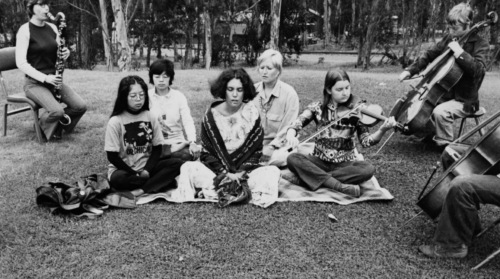
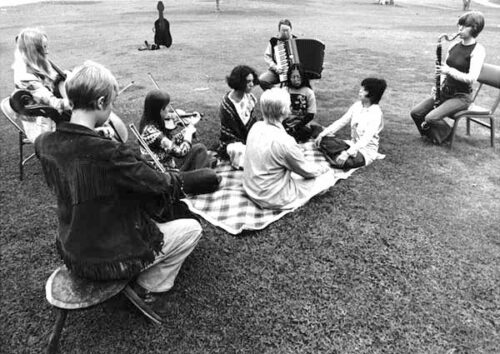
Once these steps have been completed - and these are not just conditions for practice, but practice itself - listeners can put Pauline Oliveros' verbal scores into action. There are twenty-five of them in Sonic Meditations. Here are three of them:
" I.Teach yourself to fly
Any number of persons sit in a circle facing the center. Illuminate the space with dim blue light. Begin by simply observing your own breathing. Always be an observer. Gradually allow your breathing to become audible. Then gradually introduce your voice. Allow your vocal cords to vibrate in any mode which occurs naturally Let the intensity increase very slowly. CAllow the intensity to increase very slowly. Continue as long as possible naturally, and until all others are quiet, always observing your own breath cycle."
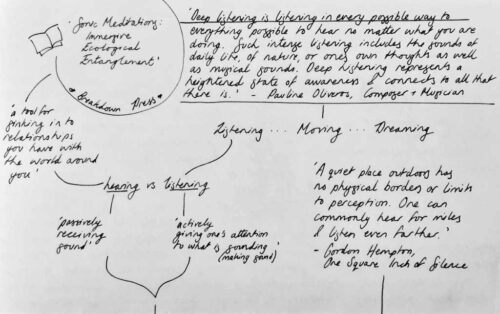
" III. Pacific Tell
Find your place in a darkened indoor space or a deserted out-of-door area. Mentally form a sound image. Assume that the magnitude of your concentration on, or the vividness of this sound image will cause one or more of the group to receive this sound image by telepathic transmission. Visualize the person to whom you are sending. Rest after your attempted telepathic transmission by becoming mentally blank. When or if a sound Image different from your own forms in your mind. Assume that you are receiving from someone else, then make that sound image audible. Rest again by becoming mentally blank or return to your own mental sound image. Continue as long as possible, or until all others are quiet. "
" V. Native
Take a walk at night. Walk so silently that the bottoms of your feet become ears. "

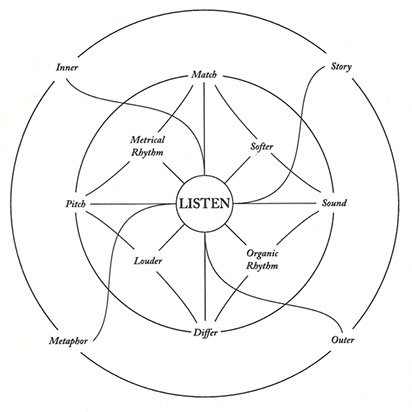
The first meditation is an exercise in spontaneous vocalization, based on awareness and intensification of one's own breathing. The voice must be born from the breath, as if it were nothing more than the coloring of the vocal cords. It also presupposes mutual and therefore collective, shared listening. The slow rhythm of intensification will produce a sound that you may or may not choose to support. The title - Apprenez à voler (Learn to fly) - opens up a third path, which is a way of interpreting or imagining what the work produces: either a lightening of the body that can be felt when vocalizing, and which the collective vocalization can intensify, or an imaginary sensation of elevation and then flight, of liberation from gravity and aerial motricity. None of these paths is exclusive of the others. Deep listening is multidimensional. It involves the body, here breathing and becoming lighter, the relationship with other listeners and the imagination as a creative faculty, capable of turning the listening body into a potentially flying body.
The third meditation is particularly interesting. By evoking telepathic transmission, it does not seek to make it possible or effective, but to oblige the listener to act as if it were. In this way, he or she can achieve a concentration on the sound image, a visualization of the receiver and an inner emptiness to receive the image of others that would otherwise be impossible to attain. Fiction allows us to work on ourselves and on our relationship with others: the listener becomes capable of isolating a sound or a sound image, visualizing another person and emptying the mind. This is a very concrete expansion of consciousness: to a sound not heard (but imagined or remembered), to a person not present, to a sound we know nothing about (that we can't even imagine, only expect).
The fifth meditation follows in the tradition of sound walks, already important in the early 1970s. The one we're talking about here is of a new kind, since it involves equipping oneself with a new organ: a plantar ear. The effect is twofold: the instruction modifies the listener's way of walking and, more generally, his receptiveness to what surrounds him; he undertakes, at first fictitiously, to listen with organs other than his ears, to extend his auditory system to his entire body, starting with his feet. This fiction can, through practice, become concrete reality. Plants are particularly sensitive and receptive surfaces, especially to ground vibrations. It is therefore entirely conceivable that it could become a receiving organ if we learn to use it.
This rapid overview has revealed other important characteristics of deep listening: it is collective, it involves the whole body (including the mind), it extends beyond human audibility (even beyond sound), it requires the listener to be active, producing sounds, sound images and (at least potential) movements, and it is transformative (it makes the listener capable of new things).
In her introduction to Sonic Meditations, Pauline Oliveros describes the effects as follows: " Heightened states of awareness or expanded consciousness, changes in physiology and psychology from known and unknown tensions to relaxations which gradually become permanent. A little further on, she adds: " These changes may represent a tuning of body and mind. "
This is the final trait of deep listening: it heals, and it takes care of bodies and minds. In the second part of her introduction, Pauline Oliveros describes four moments when care operates - these moments are also conditions of practice: " 1) individuals feel the common bond with others through a shared experience, 2) when one's inner experience is made manifest and accepted by others, 3) when one is aware of and in tune with one's surrounding, 4) when one's memories, or values, are integrated with the present and understood by others. " These moments are simultaneously individual and collective: we can only heal the individual by working on his or her relationship with others. Through this practice, we also take care of the group.
Dialogue with Pauline - Choral tribute to Pauline Oliveros from Association Ensemble Vide on Vimeo.
Let's pause for a moment to consider the word " tune ", which recurs several times in Sonic Meditations, in both its verbal form - tuning, to tune - and its nominal form - in tune. It's a term from the musical lexicon that designates the act of tuning an instrument (or adjusting a radio receiver to the frequency at which a signal is received), or more generally (and metaphorically) of tuning one another. In the two texts I've quoted, it's a question of tuning body and mind (and body to mind) and tuning to an environment (the eighth mediation - " Environmental Dialogue " - asks the listener to reinforce a sound source in his or her auditory environment, which is a way of tuning to it).
In a variation of the third meditation - " Telepathic Improvisation " for a group of musicians and listeners - where listeners are asked to imagine the sound of the musician's instrument and transmit it to them through their thoughts, the word used to designate this moment of practice is " tuning ".
Finally, in the sixteenth meditation, the listener is asked first to tune in(tuning towards) the center of the sound spectrum produced by the improvised collective singing of the group members, and then to tune out(tuning away). One cannot exist without the other. Tuning away presupposes the ability to detune, for example, from acquired habits and inherited social injunctions. For Pauline Oliveros, relationships with oneself and with others are shaped by practice. They must be constantly renegotiated. And collective improvisation is one possible site for this tacit negotiation (3).
As we can see, the word designates several forms of agreement: of oneself with oneself, of oneself with others, of oneself with the environment. One could almost say that deep listening is a practice of tuning in. The problem is that it has to be multidimensional. We can only tune in to ourselves if we also tune in to others and the environment. What Sonic Meditations puts into practice is precisely this synchronization, never really complete, of these multiple tunings.
There are at least two other major uses of the word: by the Austrian philosopher and phenomenologist Alfred Schütz, in a famous article published in 1951(Making Music Together: A Study in Social Relationship), through the concept of " tuning-in relationship "(4) ; and by the composer and theorist Raymond Murray Schafer, whose major book, published in 1977, was entitled The Tuning of the World (The Soundscape)(5). For Schütz, it was a matter of thinking, from both a social and an intersubjective perspective, about the singularity of the bond that binds musicians playing music together - when, in his view, there is a reciprocal sharing of the flows of each person's experience. For Murray Schafer, the concept has an ethical and activist value, since it's about re-tuning oneself to the world, and re-tuning the world, at a time when soundscapes are tending to lose the depth they had in the pre-industrial age.
For Pauline Oliveros, tuning in is inseparable from deep listening as a transformative practice. Tuning in - to oneself, to others, to the world - means transforming oneself, individually and collectively. It's not a question of describing (like Schütz) or returning (like Murray Schafer), but of existing in and through sound. To borrow a concept from the philosopher Günther Anders, deep listening is a "co-realization"(6) : we realize ourselves by realizing the object of our listening, which is no longer an object but a new milieu of existence for a subject to be reinvented.
In a text written in 1968 for the magazine Source(Some Sound Observations)(7), she describes the sounds around her from the room where she is composing her article. The first is that of a " bulldozer devouring a hill while its engine is a cascade of harmonics defining the space between it and the rock'n'roll of the radio playing in the next room. " A little later in the text, she recalls a vacation memory: " During the quiet evening of a summer vacation near Feather River Canyon, Lynn, Bob and I wanted to play music. We decided to read John Cage 's Atlas Eclipticalis from the original score, which was shining brightly above. The canyon creatures joined us as we played, and we played until our awareness became imbedded in the canyon and summoned a ghostly. floating train, an apparition of metal meeting metal, reflected doubly, triply, endlessly from the canyon, from the mind, from the flickering passenger windows, the rumbling ties, OUR EARS FELT LIKE CANYONS. We didn't speak until morning."
Tuning in means both tuning in to the bulldozer and the way it fills space, and listening like a canyon, stretching your ears until they take on its shape. In the first case, we learn to cohabit with the sound-noise of the bulldozer; in the second, through listening, we become landscape. A third would be to confront one's own sounds with those coming from outside, and then to produce those that will bring them into harmony.
The thirteenth meditation reads: " Listen to the environment like a drone. Make mental contact with all continuous external sounds, and include all your own continuous internal sounds, such as blood pressure, heart rate and nervous system. When you feel ready, or when prompted by a random or intermittent sound from the external or internal environment, emit the sound of your choice in a single breath, or a cycle of similar sounds. "
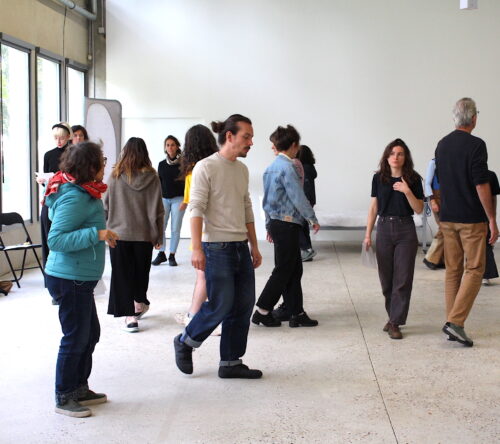

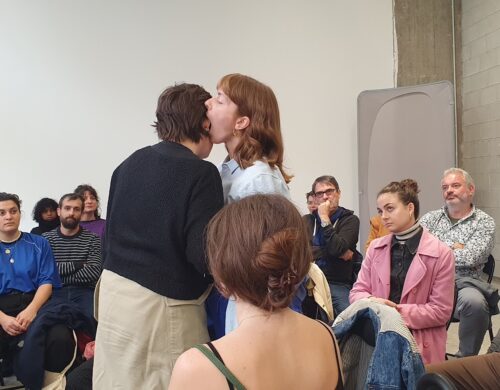
Bastien Gallet
Un-Tuning Together. Practicing listening with Pauline Oliverosexhibition conceived and organized by Maud Jacquin and Émilie Renard, runs until December 2 at the Centre d'art et de recherche Bétonsalon, 9 esplanade Pierre Vidal-Naquet 75013 Paris.
Pauline Oliveros's texts are translated from English by Bastien Gallet
Photos © IONNE
Photos © Centre of contemporary Music Mills Performing Arts
Photos © Becky Cohen
Photos © Anna Holveck
Photos © Emily Mast
(1) On this subject, read her text " Improvisation in the Sonosphere ", published in 2006 in the Contemporary Music Review.
(2) Both texts are quoted by Martha Mokus in Sounding Out: Pauline Oliveros and Lesbian Musicality, Routledge, 2008, p. 29 and 38.
(3) See "Écouter tout ce qu'il est possible d'entendre de toutes les façons possibles" by Maud Jacquin and Émilie Renard, Journal d'exposition de Bétonsalon, BS 35, p. 7 ff.
(4) A translation of this text is available in Écrits sur la musique (1924-1956), trans. by Bastien Gallet and Laurent Perreau, ed. MF, 2007.
(5) A translation of the book is available from Wildproject under the title Le Paysage sonore: le monde comme musique (2010). Murray Schafer changed the title when the book was republished in 1994 to : The Soundscape: Our Sonic Environment and the Tuning of the World.
(6) "What happens when man co-realizes this form of movement [Anders uses a passage from Wagner's Tristan und Isolde as an example], not spontaneously in truth, but by being seized and carried away by it? [...] this dimension itself has become a world, because, paradoxical as it may seem from a phenomenological point of view, we are at the same time the musical unfolding and in it. [...] Music is not only theobject of the revelatory situation: it also enlightens and opens man. Now, if it's impossible to say exactly what we're being enlightened about, it's because in the revealing situation, and in the co-realization, we learn nothing about..., nothing that would be of a factual order; rather, we experience about ourselves the very dimension into which we are transforming ourselves, and which, as music, becomes world. "Phénoménologie de l'écoute , trans. by Martin Kaltenecker and Diane Meur, éd. de la Philharmonie, 2020, p. 136-139.
(7) The article is available in its original version here here.



)


